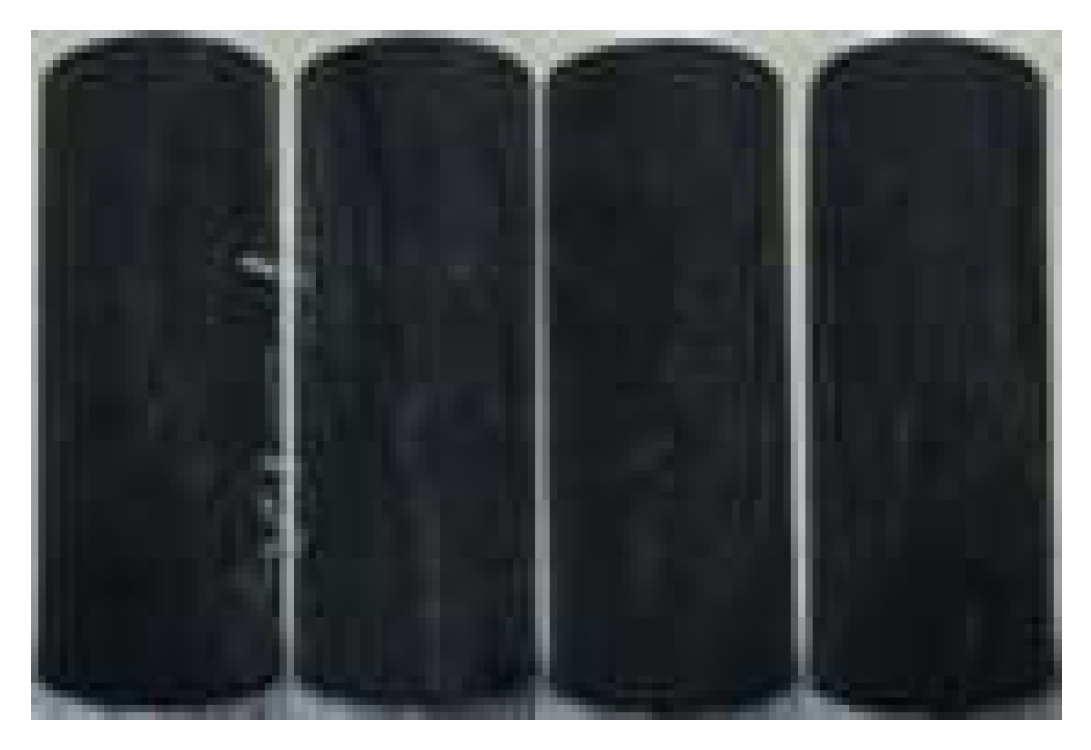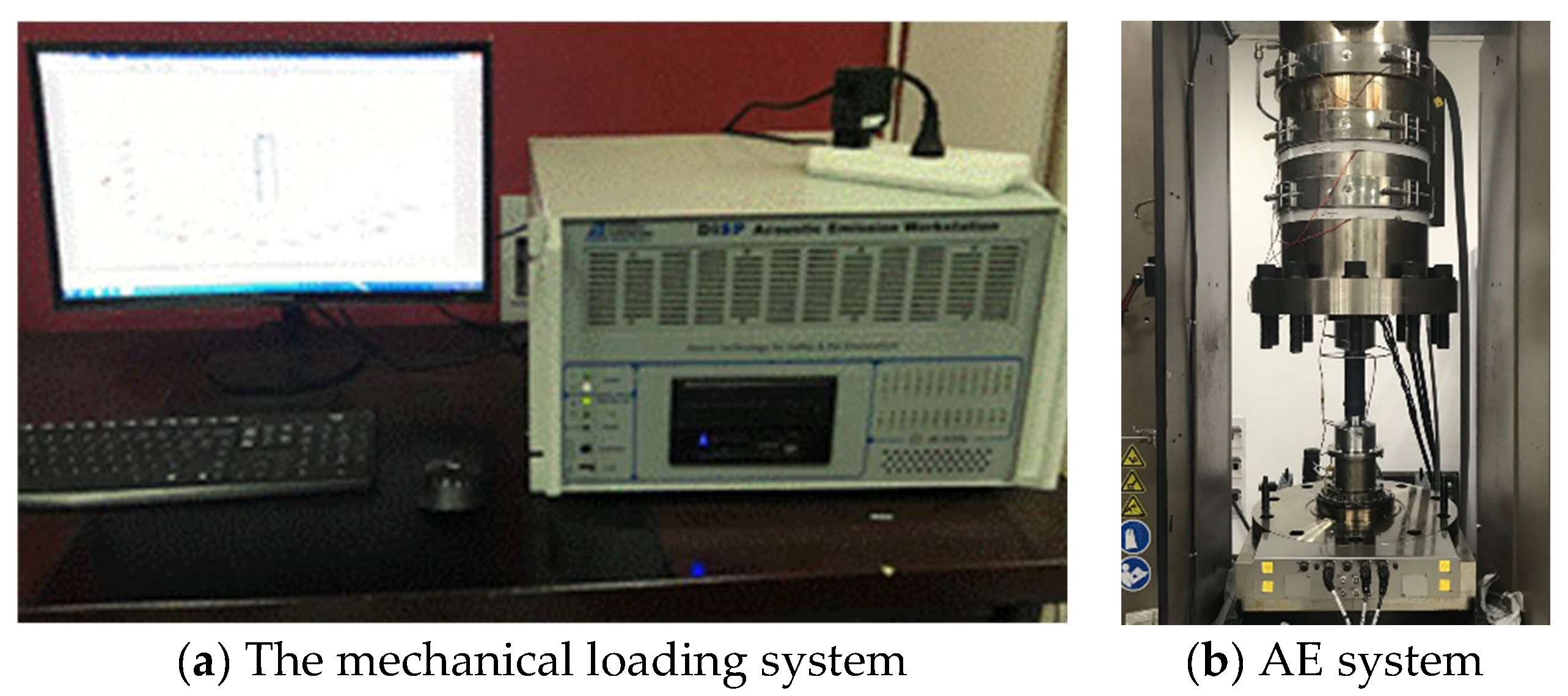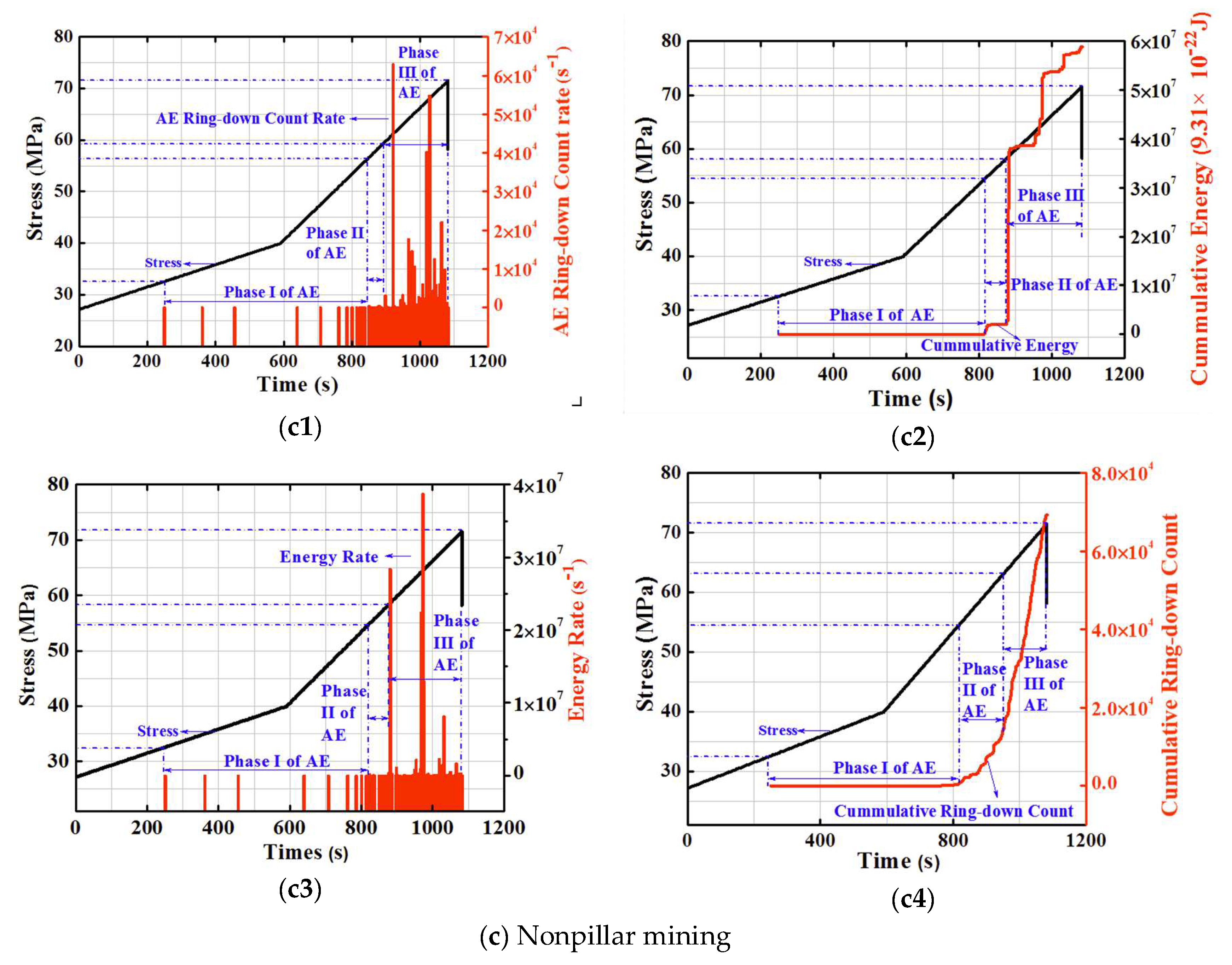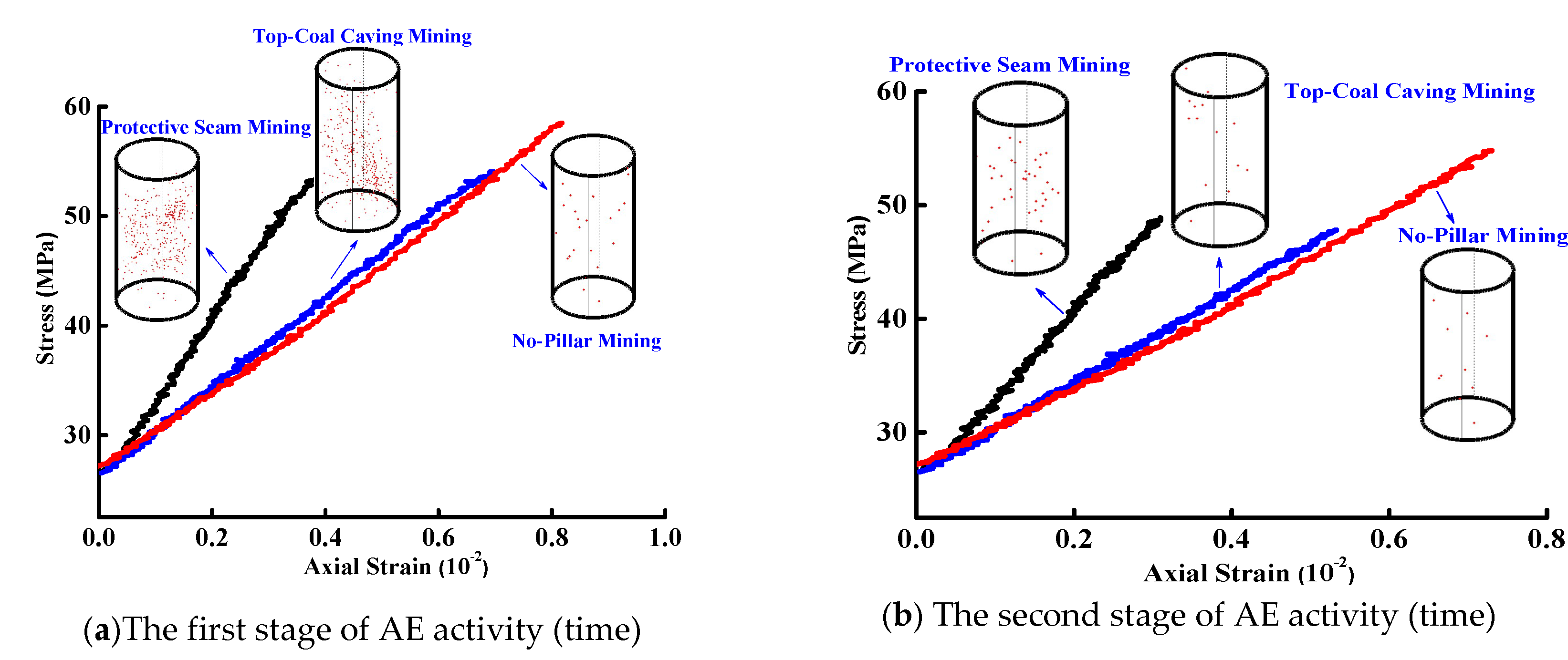Acoustic Emission Characteristics of Coal Samples under Different Stress Paths Corresponding to Different Mining Layouts
Abstract
:1. Introduction
2. Experimental Area
2.1. Sample Specification and AE Sensor
2.2. Test Process
3. Results
3.1. Characteristics of AE Time Series Evolution of Coal under Deep Mining Conditions
3.2. Spatial Evolution and Fractal Characteristics of AE of Coal under Deep Mining Conditions
4. Conclusions
- (1)
- Under deep mining conditions, the time series evolution of AE activity exhibits three-stage characteristics, which correspond to the processes of initiation, stable propagation and unstable propagation of cracks in the coal.
- (2)
- Under deep mining conditions, the occurrence timing of the main ruptures of the three-stage coal activities may be ranked in descending order, i.e., protective coal seam, top-coal caving and nonpillar mining layouts. The number of cumulative AE events and the number of AE ring-down counts of the three mining layouts were on the same order of magnitude. The accumulated AE energy released by the coal mass in front of the working face of the protective coal seam was one order of magnitude lower than that of caving coal; similarly, the accumulated AE energy of caving coal was lower by one order of magnitude than that of nonpillar mining. The energy released from a single rupture of the sample under the nonpillar layout was higher than that under the other two mining layouts.
- (3)
- Under deep mining conditions, as the peak stress increased, the AE spatial fractal dimension decreased successively under the protective seam, top-coal caving and nonpillar mining layouts. The nonpillar mining layout resulted in a higher degree of unstable coal mass rupture in front of the working face.
Author Contributions
Funding
Acknowledgments
Conflicts of Interest
References
- Nicholls, T. How the Energy Industry Works: An Insider’s Guide; Silverstone Communications Ltd.: London, UK, 2010; pp. 111–112. [Google Scholar]
- Han, Y.; Yin, F.; Li, X. A review on water in low rank coals: The existence, interaction with coal structure and effects on coal utilization. Fuel Process. Technol. 2013, 106, 9–20. [Google Scholar]
- Kong, S.; Cheng, Y.; Ren, T.; Liu, H. A sequential approach to control gas for the extraction of multi-gassy coal seams from traditional gas well drainage to mining-induced stress relief. Appl. Energy 2014, 131, 67–78. [Google Scholar] [CrossRef]
- Wang, L.; Cheng, Y.P.; An, F.H.; Zhou, H.X.; Kong, S.L.; Wang, W. Characteristics of gas disaster in the huaibei coalfield and its control and development technologies. Nat. Hazards 2014, 71, 85–107. [Google Scholar] [CrossRef]
- Liang, Y. Strategic thinking of simultaneous exploitation of coal and gas in deep mining. J. China Coal Soc. 2016, 41, 1–6. [Google Scholar]
- Lobanova, T.V. Geomechanical state of the rock mass at the Tashtagol mine in the course of nucleation and manifestation of rock bursts. J. Min. Sci. 2008, 44, 146–154. [Google Scholar] [CrossRef]
- Yang, S.Q.; Chen, M.; Jing, H.W.; Chen, K.F.; Meng, B.A. Case study on large deformation failure mechanism of deep soft rock roadway in Xin’an coal mine, China. Eng. Geol. 2016, 217, 89–101. [Google Scholar] [CrossRef]
- Sun, W.; Zhang, Q.; Luan, Y.; Zhang, X.P. A study of surface subsidence and coal pillar safety for strip mining in a deep mine. Environ. Earth Sci. 2018, 77, 627. [Google Scholar] [CrossRef]
- Liu, T.; Lin, B.; Wei, Y.; Tong, L.; Cheng, Z. An integrated technology for gas control and green mining in deep mines based on ultra-thin seam mining. Environ. Earth Sci. 2017, 76, 243. [Google Scholar] [CrossRef]
- Zhou, A.; Kai, W.; Lei, L.; Wang, C.A. Roadway driving technique for preventing coal and gas outbursts in deep coal mines. Environ. Earth Sci. 2017, 76, 236. [Google Scholar] [CrossRef]
- Xie, H.P.; Zhang, Z.; Gao, F.; Zhang, R.; Gao, M.Z.; Liu, J.F. Stress-fracture-seepage Field Behavior of Coal under Different Mining Layouts. J. China Coal Soc. 2016, 41, 2405–2417. [Google Scholar]
- Xie, H.P.; Zhao, X.; Liu, J.; Zhang, R.; Xue, D. Influence of different mining layouts on the mechanical properties of coal. Int. J. Min. Sci. 2012, 22, 749–755. [Google Scholar] [CrossRef]
- Zhang, R.; Ai, T.; Li, H.; Zhang, Z.; Liu, J. 3D reconstruction method and connectivity rules of fracture networks generated under different mining layouts. Int. J. Min. Sci. Technol. 2013, 23, 863–871. [Google Scholar] [CrossRef]
- Zhang, Z.; Ru, Z.; Xie, H.; Gao, M.; Jing, X. Mining-induced coal permeability change under different mining layouts. Rock Mech. Rock Eng. 2016, 49, 3753–3768. [Google Scholar] [CrossRef]
- Zhang, R.; Ai, T.; Zhou, H.W.; Ju, Y.; Zhang, Z.T. Fractal and volume characteristics of 3D mining-induced fractures under typical mining layouts. Environ. Earth Sci. 2015, 73, 6069–6080. [Google Scholar] [CrossRef]
- Kramadibrata, S.; Matsui, K.; Shimada, H. Role of acoustic emission for solving rock engineering problems in indonesian underground mining. Rock Mech. Rock Eng. 2011, 44, 281–289. [Google Scholar] [CrossRef]
- Ai, T.; Ru, Z.; Liu, J.; Li, R. Space–time evolution rules of acoustic emission location of unloaded coal sample at different loading rates. Int. J. Min. Sci. Technol. 2012, 22, 847–854. [Google Scholar]
- Vishal, V.; Ranjith, P.G.; Singh, T.N. An experimental investigation on behaviour of coal under fluid saturation, using acoustic emission. J. Nat. Gas Sci. Eng. 2015, 22, 428–436. [Google Scholar] [CrossRef]
- Wu, S.; Ge, H.; Wang, X.; Meng, F. Shale failure processes and spatial distribution of fractures obtained by ae monitoring. J. Nat. Gas Sci. Eng. 2017, 41, 82–92. [Google Scholar] [CrossRef]
- Cai, M.; Kaiser, P.K.; Tasaka, Y.; Maejima, T.; Morioka, H.; Minami, M. Generalized crack initiation and crack damage stress thresholds of brittle rock masses near underground excavations. Int. J. Rock Mech. Min. Sci. 2004, 41, 833–847. [Google Scholar] [CrossRef]
- Zhou, H.; Yu, Y.; Zhang, Y.; Lei, F.; Zuo, Y.; Xiang, W. Fine test on progressive fracturing process of multi-crack rock samples under uniaxial compression. Chin. J. Rock Mech. Eng. 2010, 29, 465–470. [Google Scholar]
- Su, F.Q.; Itakura, K.I.; Deguchi, G.; Ohga, K. Monitoring of coal fracturing in underground coal gasification by acoustic emission techniques. Appl. Energy 2017, 189, 142–156. [Google Scholar] [CrossRef] [Green Version]
- Agioutantis, Z.; Kaklis, K.; Mavrigiannakis, S.; Verigakis, M.; Vallianatos, F.; Saltas, V. Potential of acoustic emissions from three point bending tests as rock failure precursors. Int. J. Min. Sci. Technol. 2016, 26, 155–160. [Google Scholar] [CrossRef]
- Liu, Q.; Zhang, R.; Gao, M.; Guo, L.I.; Zhang, Z.; Zhang, Z. Acoustic emission characteristics and comprehensive failure precursors of coal under unloading conditions. J. Sichuan Univ. 2016, 48, 67–74. [Google Scholar]
- Shkuratnik, V.L.; Nikolenko, P.V.; Koshelev, A.E. Spectral characteristics of acoustic emission in loaded coal specimens for failure prediction. J. Min. Sci. 2017, 53, 818–823. [Google Scholar] [CrossRef]
- Zhang, Z.; Zhang, R.; Zhang, Z.; Gao, M.; Dai, F. Experimental research on effect of bedding plane on coal acoustic emission under uniaxial compression. Chin. J. Rock Mech. Eng. Geol. 2015, 34, 770–778. [Google Scholar]
- Shkuratnik, V.L.; Filimonov, Y.L.; Kuchurin, S.V. Experimental investigations into acoustic emission in coal samples under uniaxial loading. J. Min. Sci. 2004, 40, 458–464. [Google Scholar] [CrossRef]
- Shkuratnik, V.L.; Filimonov, Y.L.; Kuchurin, S.V. Regularities of acoustic emission in coal samples under triaxial compression. J. Min. Sci. 2005, 41, 44–52. [Google Scholar] [CrossRef]
- Wang, J.; Xie, L.; Xie, H.; Li, R.; Bo, H.; Li, C. Effect of layer orientation on acoustic emission characteristics of anisotropic shale in Brazilian tests. J. Nat. Gas Sci. Eng. Geol. 2016, 36, 1120–1129. [Google Scholar] [CrossRef]
- Xie, H.P.; Gao, F.; Ju, Y.; Gao, M.Z.; Zhang, R.; Gao, Y.N. Quantitative definition and investigation of deep mining. J. China Coal Soc. 2015, 40, 1–10. [Google Scholar]
- Xie, H.P.; Zhou, H.W.; Xue, D.J.; Wang, H.W.; Zhang, R.; Gao, F. Research and consideration on deep mining and limit mining depth of coal. J. China Coal Soc. 2012, 37, 535–542. [Google Scholar]
- Min, T.U.; Miao, X.X.; Colliery, Z. Deformation rule of protected coal seam exploited by using the long-distance-lower protective seam method. J. Min. Saf. Eng. 2006, 23, 253–257. [Google Scholar]
- Hao, Y.; Zhang, J.; Nan, Z.; Sheng, Z.; Dong, X. Shaft failure characteristics and the control effects of backfill body compression ratio at ultra-contiguous coal seams mining. Environ. Earth Sci. 2018, 77, 458. [Google Scholar]
- Wang, J.C. Fully mechanized longwall top coal caving technology in china and discussion on issues of further development. Coal Sci. Technol. 2005, 33, 14–17. [Google Scholar]
- Xie, H.P.; Zhou, H.W.; Liu, J.F.; Gao, F.; Zhang, R.; Xue, D.J.; Zhang, Y. Mining-induced Mechanical Behavior in Coal Seams under Different Mining Layouts. J. China Coal Soc. 2011, 36, 1067–1074. [Google Scholar]
- Ju, Y.; Zhang, Q.; Zheng, J. Experimental study on CH4 permeability and its dependence on interior fracture networks of fractured coal under different excavation stress paths. Fuel 2017, 202, 483–493. [Google Scholar] [CrossRef]
- Luo, Y.; Ren, L.; Xie, L.Z.; Ai, T.; He, B. Fracture behavior investigation of a typical sandstone under mixed-mode I/II loading using the notched deep beam bending method. Rock Mech. Rock Eng. 2017, 50, 1–19. [Google Scholar] [CrossRef]
- Ren, L.; Xie, L.Z.; Xie, H.P.; Ai, T.; He, B. Mixed-mode fracture behavior and related surface topography feature of a typical sandstone. Rock Mech. Rock Eng. 2016, 49, 1–17. [Google Scholar] [CrossRef]
- Hirata, T.; Satoh, T.; Ito, K. Fractal structure of spatial distribution of micro-fracturing in rock. Geophys. J. Int. 1987, 90, 369–374. [Google Scholar] [CrossRef]
- Zhang, R.; Dai, F.; Gao, M.Z.; Xu, N.W.; Zhang, C.P. Fractal analysis of acoustic emission during uniaxial and Triaxial loading of rock. Int. J. Rock Mech. Min. Sci. 2015, 79, 1365–1609. [Google Scholar] [CrossRef]
- Pei, J.L. Study on Mechanical Behavior of Natural Multi-Group Fractured Rocks. Doctor Dissertation, Sichuan University, Chengdu, China, 2011. [Google Scholar]












| Mining Layouts | Phase I Starting Point | Phase II Starting Point | Phase III Starting Point | |||
|---|---|---|---|---|---|---|
| Stress/% | Time/s | Stress/% | Time/s | Stress/% | Time/s | |
| Protective-seam | 53 | 92.9 | 89.6 | 1002.7 | 97.8 | 1205.3 |
| Top-coal caving | 46.1 | 117.9 | 76.7 | 827.7 | 86.7 | 976.1 |
| Nonpillar | 45.6 | 250.2 | 76.8 | 823.7 | 81.9 | 880.7 |
© 2020 by the authors. Licensee MDPI, Basel, Switzerland. This article is an open access article distributed under the terms and conditions of the Creative Commons Attribution (CC BY) license (http://creativecommons.org/licenses/by/4.0/).
Share and Cite
Yang, Y.; Ai, T.; Zhang, Z.; Zhang, R.; Ren, L.; Xie, J.; Zhang, Z. Acoustic Emission Characteristics of Coal Samples under Different Stress Paths Corresponding to Different Mining Layouts. Energies 2020, 13, 3295. https://doi.org/10.3390/en13123295
Yang Y, Ai T, Zhang Z, Zhang R, Ren L, Xie J, Zhang Z. Acoustic Emission Characteristics of Coal Samples under Different Stress Paths Corresponding to Different Mining Layouts. Energies. 2020; 13(12):3295. https://doi.org/10.3390/en13123295
Chicago/Turabian StyleYang, Yiming, Ting Ai, Zetian Zhang, Ru Zhang, Li Ren, Jing Xie, and Zhaopeng Zhang. 2020. "Acoustic Emission Characteristics of Coal Samples under Different Stress Paths Corresponding to Different Mining Layouts" Energies 13, no. 12: 3295. https://doi.org/10.3390/en13123295
APA StyleYang, Y., Ai, T., Zhang, Z., Zhang, R., Ren, L., Xie, J., & Zhang, Z. (2020). Acoustic Emission Characteristics of Coal Samples under Different Stress Paths Corresponding to Different Mining Layouts. Energies, 13(12), 3295. https://doi.org/10.3390/en13123295





